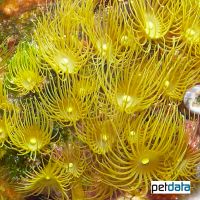Yellow Zoanthid (Terrazoanthus sp.)
| Yellow Zoanthid Terrazoanthus sp. | |
|---|---|
| Name | Yellow Zoanthid |
| Name Lat. | Terrazoanthus sp. |
| Synonym | Parazoanthus gracillis |
| Family | --- |
| Family lat. | Hydrozoanthidae |
| Order | Zoanthids |
| Order lat. | Zoantharia |
| Origin | Western Pacific |
| Diet | Autotrophic, planktivore |
| pH | 8.1-8.4 |
| Hardness | 6-10 °KH |
| Lighting | Medium |
| Current | Moderate |
| Behavior | Semi-aggressive |
| Keeping | Colony |
| Care Level | Easy |
| Life Span | 5-10 years |
| Protection | No |
| Metric Units | |
| Size | 2-4 cm |
| Temperature | 22-27 °C |
| Salinity | 33-36 ‰ |
| Aquarium | 150 l |
| US Units | |
| Size | 0.8"-1.26" |
| Temperature | 72-81 °F |
| Salinity | 1.020-1.025 sg |
| Aquarium | 40 gal |
Distribution and habitat
The distribution area of Terrazoanthus sp. is the Java Sea (Indonesia) and the western Pacific Ocean. They colonize rocks and dead corals on shallow water reefs with moderate currents. There they often form dense polyp cushions. The yellow to grayish-yellow corals usually originate from mariculture.
Maintenance
They should be positioned in a place with medium light intensity and moderate, alternating current. A reef structure of live stones that also act as a biological filter provides the necessary habitat for the animals. Only lime-rich, heavy metal-free substrates may be used as substrate
To ensure water quality, filters, skimmers and heaters are necessary, as well as pumps to simulate tides, swells and bottom currents. Lighting must match the species-appropriate day-night rhythm of the animals
| Salinity: 33-36 ‰ | pH value: 8.1-8.4 |
| Carbonate hardness: 6-10 °KH | Nitrate content: 2-8 mg/l |
| calcium content: 420-450 mg/l | Nitrite content: 0.0-0.05 mg/l |
| Magnesium content: 1.250-1.350 mg/l | phosphate content: 0.01-0.1 mg/l |
Regular addition of trace elements, especially iodine, is recommended. For salinity, an average value should be aimed for, which may only vary slightly by +/- 0.5 ‰. Ammonia and ammonium must not be measurable. Special attention shall be paid to consistently good water quality and water values.
Diet
They feed mainly on plankton and small particles collected from the water current. In addition to the food produced in the aquarium during fish feeding (mysis, krill, Artemia, etc.), commercially available supplementary food in the form of phyto- and zooplankton should be offered regularly. Zooxanthellae, which are unicellular symbiotic algae, live in their tissues and provide them with assimilation products of their photosynthesis (light requirement). The zooxanthellae promote growth and provide additional nutrition
Regular and varied feeding avoids deficiency symptoms.
Behaviour and compatibility
They live in large colonies and can be well socialized with fish that do not consider them food. A sufficient distance must be kept from corals to avoid encrustation.
Reproduction and breeding
Their asexual reproduction takes place by budding, loose polyp aggregates are carried away with the current and settle elsewhere. Reproduction by fragmentation is quite possible. For this purpose small stones are placed at the edge of the colony and after their overgrowth the junction is separated
Important
Due to their reproduction by budding, uncontrolled spreading in the aquarium may occur, displacing other sessile invertebrates (e.g. stony corals). When removing crustose anemones, make sure that all tissue remnants are also removed to prevent further spreading. Newly introduced animals must be acclimated slowly to the water in the aquarium. If different species are kept together, make sure that fish and invertebrates match each other in terms of water quality and temperature requirements, as well as their social behavior, and that the setup meets the ecological needs of all species kept together
Further literature can be found in your pet store.
References
Text: Werner Winter; Image: petdata
Source: BAENSCH & DEBELIUS (2006): Meerwasser Atlas Bd. 1, Mergus Verlag; KNOP (2013): Lexikon der Meeresaquaristik, Natur und Tier - Verlag; ENGELMANN & LANGE (2011): Zootierhaltung - Tiere in menschlicher Obhut: Wirbellose, Verlag Harri Deutsch
